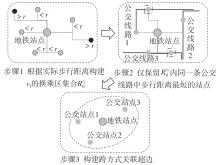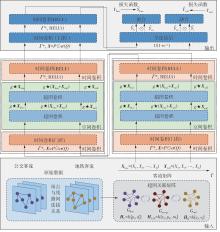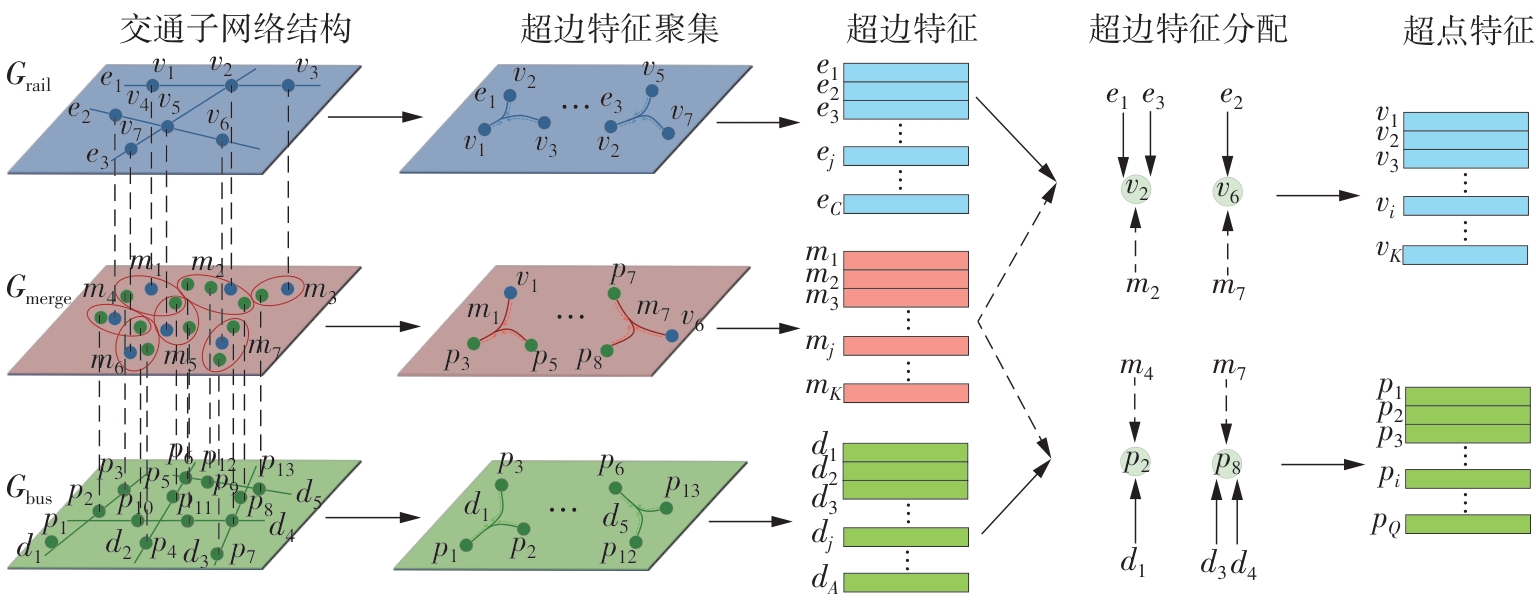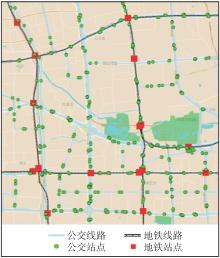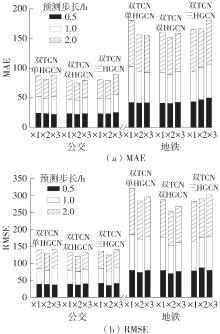Journal of South China University of Technology(Natural Science Edition) ›› 2024, Vol. 52 ›› Issue (11): 83-94.doi: 10.12141/j.issn.1000-565X.240064
• Intelligent Transportation System • Previous Articles Next Articles
Joint Prediction Model of Multi-Modal Transportation Passenger Flow Based on Hypergraph Convolution
WANG Jiangfeng( ), DING Weidong, LUO Dongyu, LI Yunfei, QI Chongkai, DONG Honghui
), DING Weidong, LUO Dongyu, LI Yunfei, QI Chongkai, DONG Honghui
- Key Laboratory of Transport Industry of Big Data Application Technologies for Comprehensive Transport,Beijing Jiaotong University,Beijing 100044,China
-
Received:2024-02-05Online:2024-11-25Published:2024-06-07 -
About author:王江锋(1976—),男,教授,博士生导师,主要从事智能交通及车辆研究。E-mail:wangjiangfeng@bjtu.edu.cn -
Supported by:the National Key R&D Program of China(2022YFB4300400)
CLC Number:
Cite this article
WANG Jiangfeng, DING Weidong, LUO Dongyu, et al. Joint Prediction Model of Multi-Modal Transportation Passenger Flow Based on Hypergraph Convolution[J]. Journal of South China University of Technology(Natural Science Edition), 2024, 52(11): 83-94.
share this article
Table 1
Description of passenger swiping card data"
| 交通方式 | 序号 | 字段 | 数据描述 |
|---|---|---|---|
| 公交 | 1 | BUSDATA_ID | 刷卡ID,18开头的11位数 |
| 2 | DEAL_TIME | 交易时间,20160307000000~20160313240000 | |
| 3 | UP_TIME | 更新时间,20160307000000~20160313240000 | |
| 4 | LINE_CODE | 线路代码 | |
| 5 | VEHICLE_CODE | 车辆代码 | |
| 6 | ON_STATION | 上车站点编号 | |
| 7 | OFF_STATION | 下车站点编号 | |
| 地铁 | 1 | GRANT_CARD_CODE | 刷卡ID,10000~99999999 |
| 2 | ENTRY_NUM | 进入站点编号 | |
| 3 | EXIT_NUM | 离开站点编号 | |
| 4 | ENTRY_TIME | 进站时间,20160307000000~20160313240000 | |
| 5 | DEAL_TIME | 交易时间,20160307000000~20160313240000 | |
| 6 | ENTRY_STATION | 进入站点名称 | |
| 7 | EXIT_STATION | 离开站点名称 |
Table 2
Performance comparison of different models"
| 模型 | 公交 | 地铁 | ||||||||||
|---|---|---|---|---|---|---|---|---|---|---|---|---|
| MAE | RMSE | MAE | RMSE | |||||||||
| 0.5 h | 1.0 h | 2.0 h | 0.5 h | 1.0 h | 2.0 h | 0.5 h | 1.0 h | 2.0 h | 0.5 h | 1.0 h | 2.0 h | |
| HA | 35.43 | 47.08 | 65.57 | 44.64 | 55.50 | 89.48 | 55.74 | 73.83 | 108.56 | 88.62 | 121.30 | 182.29 |
| ARIMA | 32.31 | 43.63 | 63.97 | 40.17 | 54.59 | 85.17 | 53.67 | 75.31 | 102.63 | 85.79 | 120.54 | 173.84 |
| RF | 30.93 | 36.02 | 41.82 | 44.24 | 50.98 | 57.54 | 56.65 | 68.94 | 85.81 | 93.81 | 115.55 | 150.00 |
| MLP | 36.28 | 46.08 | 56.70 | 50.13 | 63.19 | 77.69 | 55.83 | 61.90 | 91.63 | 86.51 | 102.61 | 154.77 |
| LSTM | 36.38 | 39.38 | 41.36 | 45.58 | 49.42 | 51.69 | 50.67 | 61.63 | 75.68 | 86.51 | 102.90 | 128.55 |
| GRNN | 32.58 | 36.43 | 41.09 | 44.37 | 49.92 | 55.97 | 51.45 | 62.42 | 77.99 | 87.61 | 113.04 | 145.67 |
| T-GCN | 28.89 | 31.10 | 35.63 | 40.36 | 46.75 | 51.91 | 52.82 | 58.26 | 78.52 | 74.85 | 93.11 | 124.96 |
| S-TGCN | 23.58 | 30.25 | 34.87 | 37.78 | 48.58 | 50.09 | 43.66 | 53.45 | 70.04 | 70.84 | 90.52 | 121.34 |
| DCRNN | 23.21 | 26.19 | 32.39 | 37.54 | 43.03 | 48.63 | 43.01 | 54.98 | 67.65 | 71.10 | 88.13 | 116.80 |
| BSTHCN | 22.34 | 23.85 | 28.73 | 36.18 | 38.45 | 45.64 | 40.69 | 49.12 | 61.85 | 69.28 | 81.55 | 100.73 |
Table 3
Ablation analysis of different BSTHCN components"
| 模型 | 公交 | 地铁 | ||||||||||
|---|---|---|---|---|---|---|---|---|---|---|---|---|
| MAE | RMSE | MAE | RMSE | |||||||||
| 0.5 h | 1.0 h | 2.0 h | 0.5 h | 1.0 h | 2.0 h | 0.5 h | 1.0 h | 2.0 h | 0.5 h | 1.0 h | 2.0 h | |
| -Gmerge | 23.19 | 25.34 | 32.77 | 38.56 | 41.12 | 50.28 | 45.95 | 53.34 | 68.28 | 73.35 | 91.73 | 118.48 |
| N-G | 22.77 | 25.51 | 32.74 | 36.88 | 40.96 | 50.26 | 43.88 | 53.12 | 66.79 | 73.67 | 87.36 | 113.54 |
| -Gmerge & N-G | 25.17 | 27.80 | 34.95 | 40.27 | 47.00 | 54.42 | 49.35 | 57.23 | 72.73 | 91.04 | 98.80 | 130.79 |
| BSTHCN | 22.34 | 23.85 | 28.73 | 36.18 | 38.45 | 45.64 | 40.69 | 49.12 | 61.85 | 69.28 | 81.55 | 100.73 |
| 1 | LEI D, CHEN X, CHENG L,et al .Inferring temporal motifs for travel pattern analysis using large scale smart card data[J].Transportation Research Part C:Emerging Technologies,2020,120:102810/1-21. |
| 2 | LIANG Y, HUANG G, ZHAO Z .Joint demand prediction for multimodal systems:a multi-task multi-relational spatiotemporal graph neural network approach[J].Transportation Research Part C:Emerging Technologies,2022,140:103731/1-19. |
| 3 | 刘静,关伟 .交通流预测方法综述[J].公路交通科技,2004,21(3):82-85. |
| LIU Jing, GUAN Wei .A summary of traffic flow forecasting methods[J].Journal of Highway and Transportation Research and Development,2004,21(3):82-85. | |
| 4 | ZHANG N, ZHANG Y, LU H .Seasonal autoregressive integrated moving average and support vector machine models[J].Transportation Research Record,2011,2215 (1):85-92. |
| 5 | FILIPOVSKA M, MAHMASSANI H S .Traffic flow breakdown prediction using machine learning approaches[J].Transportation Research Record,2020,2674(10):560-570. |
| 6 | BRATSAS C, KOUPIDIS K, SALANOVA J M,et al .A comparison of machine learning methods for the pre-diction of traffic speed in urban places[J].Sustainability,2020,12:142/1-15. |
| 7 | ZHAO Z, CHEN W, WU X,et al .LSTM network:a deep learning approach for short-term traffic forecast[J].IET Intelligent Transport Systems,2017,11(2):68-75. |
| 8 | TAN Y, LIU H, PU Y,et al .Passenger flow prediction of integrated passenger terminal based on K-Means-GRNN[J].Journal of Advanced Transportation,2021,2021:1055910/1-14. |
| 9 | 赵建东,朱丹,刘佳欣 .基于时间序列分解与门控循环单元的地铁换乘客流预测[J].华南理工大学学报(自然科学版),2022,50(5):22-31. |
| ZHAO Jiandong, ZHU Dan, LIU Jiaxin .Metro transfer passenger flow prediction based on STL-GRU[J].Journal of South China University of Technology (Natural Science Edition),2022,50(5):22-31. | |
| 10 | ZHANG J B, ZHENG Y, QI D K .Deep spatio-temporal residual networks for citywide crowd flows prediction[C]∥Proceedings of the 31st AAAI Conference on Artificial Intelligence.San Francisco:AAAI,2017:1655-1661. |
| 11 | GUO S N, LIN Y F, LI S J,et al .Deep spatial-temporal 3D convolutional neural networks for traffic data forecasting[J].IEEE Transactions on Intelligent Transportation Systems,2019,20(10):3913-3926. |
| 12 | 邵春福,薛松,董春娇,等 .考虑时空相关性的网络交通流短期预测[J].北京交通大学学报,2021,45(4):37-43. |
| SHAO Chunfu, XUE Song, DONG Chunjiao,et al .Short-term traffic flow prediction considering temporal-spatial correlation road network[J].Journal of Beijing Jiaotong University,2021,45(4):37-43. | |
| 13 | 袁华,陈泽濠 .基于时间卷积神经网络的短时交通流预测算法[J].华南理工大学学报(自然科学版),2020,48(11):107-113,122. |
| YUAN Hua, CHEN Zehao .Short-term traffic flow pre-diction based on temporal convolutional networks[J].Journal of South China University of Technology (Natural Science Edition),2020,48(11):107-113,122. | |
| 14 | 陈喜群,周凌霄,曹震 .基于图卷积网络的路网短时交通流预测研究[J].交通运输系统工程与信息,2020,20(4):49-55. |
| CHEN Xi-qun, ZHOU Ling-xiao, CAO Zhen .Short-term network-wide traffic prediction based on graph convolutional network[J].Journal of Transportation Systems Engineering and Information Technology,2020,20(4):49-55. | |
| 15 | YU B, YIN H, ZHU Z .Spatio-temporal graph convolutional networks:a deep learning framework for traffic forecasting[C]∥Proceedings of The Twenty-Seventh International Joint Conference on Artificial Intelligence.Stockholm:Elsevier,2018:3634-3640. |
| 16 | GUO S N, LIN Y F, FENG N,et al .Attention based spatial-temporal graph convolutional networks for traffic flow forecasting[C]∥Proceedings of the 33rd AAAI Conference on Artificial Intelligence.Honolulu:AAAI,2019:922-929. |
| 17 | LI Y, YU R, SHAHABI C,et al .Diffusion convolutional recurrent neural network:data-driven traffic forecasting[C]∥Proceedings of the 6th International Conference on Learning Representationse (ICLR).Vancouver:[s.n.],2018:1-14. |
| 18 | ZHAO L, SONG Y, ZHANG C,et al .T-GCN:a temporal graph convolutional network for traffic prediction[J].IEEE Transactions on Intelligent Transportation Systems,2020,21(9):3848-3858. |
| 19 | 胡智维,张建同 .基于多交通模式改进的共享单车需求预测算法研究[J].软件工程,2024,27(2):10-15. |
| HU Zhiwei, ZHANG Jiantong .Research on demand forecasting algorithm for shared bicycles based on improved multi-mode transportation mode[J].Soft Engineering,2024,27(2):10-15. | |
| 20 | YE J C, SUN L L, DU B W,et al .Co-prediction of multiple transportation demands based on deep spatio-temporal neural network[C]∥Proceedings of the 25th ACM SIGKDD International Conference on Knowledge Discovery & Data Mining.Anchorage:ACM,2019:305-313. |
| 21 | WANG Q, GUO B, OUYANG Y,et al .Learning shared mobility-aware knowledge for multiple urban travel demands[J].IEEE Internet of Things Journal,2022,9(9):7025-7035. |
| 22 | ZHANG M, HUANG T, GUO Z,et al .Complex-network-based traffic network analysis and dynamics:a comprehensive review[J].Physica A:Statistical Mechanics and its Applications,2022,607:128063/1-19. |
| 23 | MIN W, WYNTER L .Real-time road traffic prediction with spatio-temporal correlations[J].Transportation Research Part C:Emerging Technologies,2011,19(4):606-616. |
| 24 | 傅惠,胡刚,徐建闽,等 .基于神经网络的城市关联交叉口交通流预测控制方法[J].中国公路学报,2008,21(5):91-95. |
| FU Hui, HU Gang, XU Jianmin,et al .Traffic Flow Predictive Control Method of Urban Correlation Intersection Based on Neural Network[J].China Journal of Highway and Transport,2008,21(5):91-95. | |
| 25 | 马超群,张爽,陈权,等 .客流特征视角下的轨道交通网络特征及其脆弱性[J].交通运输工程学报,2020,20(5):208-216. |
| MA Chao-qun, ZHANG Shuang, CHEN Quan,et al .Characteristics and vulnerability of rail transit network based on perspective of passenger flow characteristics[J].Journal of Traffic and Transportation Engineering,2020,20(5):208-216. | |
| 26 | FILIPOVSKA M, MAHMASSANI H S .Spatio-temporal characterization of stochastic dynamic transportation networks[J].IEEE Transactions on Intelligent Transportation Systems,2023,24(9):9929-9939. |
| 27 | 王金水,欧雪雯,陈俊岩,等 .基于时空超图卷积模型的城市轨道站点客流预测[J].铁道科学与工程学报,2023,20(12):4506-4516. |
| WANG Jinshui, Xuewen OU, CHEN Junyan,et al .Passenger flow forecast of urban rail transit stations based on spatio-temporal hypergraph convolution model[J].Journal of Railway Science and Engineering,2023,20(12):4506-4516. | |
| 28 | WANG J, ZHANG Y, WEI Y,et al .Metro passenger flow prediction via dynamic hypergraph convolution networks[J].IEEE Transactions on Intelligent Transportation Systems,2021,22(12):7891-7903. |
| 29 | FENG Y F, YOU H X, ZHANG Z Z,et al .Hypergraph neural networks[C]∥Proceedings of the 33rd AAAI Conference on Artificial Intelligence.Palo Alto:AAAI Press,2019:3558-3565. |
| 30 | YU W, RUAN K, TANG H,et al .Routing hypergraph convolutional recurrent network for network traffic prediction[J].Applied Intelligence,2023,53(12):16126-16137. |
| 31 | CHEN E, YE Z, WANG C,et al .Subway passenger flow prediction for special events using smart card data[J].IEEE Transactions on Intelligent Transportation Systems,2019,21(3):1109-1120. |
| 32 | TANG J, LI Z, GAO F,et al .Identifying critical metro stations in multiplex network based on D-S evidence theory[J].Physica A:Statistical Mechanics and Its Applications,2021,574:126018/1-17. |
| 33 | 潘恒彦,张文会,胡宝雨,等 .城市公交-地铁加权复合网络构建及鲁棒性分析[J].吉林大学学报(工学版),2022,52(11):2582-2591. |
| PAN Heng-yan, ZHANG Wen-hui, HU Bao-yu,et al .Construction and robustness analysis of urban weighted subway-bus composite network[J].Journal of Jilin University (Engineering and Technology Edition),2022,52(11):2582-2591. | |
| 34 | 郑乐,高良鹏,陈学武,等 .地铁-公交加权复合网络关键站点识别及鲁棒性研究[J].交通运输系统工程与信息,2023,23(5):120-129. |
| ZHENG Yue, GAO Liang-peng, CHEN Xue-wu,et al .Critical stations identification and robustness analysis of weighted metro-bus composite network[J].Journal of Transportation Systems Engineering and Information Technology,2023,23(5):120-129. | |
| 35 | 靳海涛,金凤君,陈卓,等 .基于换乘链断裂点时空信息的公交换乘行为识别[J].交通运输工程学报,2018,18(5):176-184. |
| JIN Hai-tao, JIN Feng-jun, CHEN Zhuo,et al .Commute activity identification based on spatial and temporal information of transit chaining breaks[J].Journal of Traffic and Transportation Engineering,2018,18(5):176-184. |
| No related articles found! |
| Viewed | ||||||
|
Full text |
|
|||||
|
Abstract |
|
|||||
